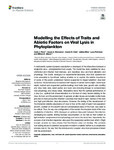Modelling the Effects of Traits and Abiotic Factors on Viral Lysis in Phytoplankton
| dc.contributor.author | Flynn, KJ | |
| dc.contributor.author | Kimmance, SA | |
| dc.contributor.author | Clark, DR | |
| dc.contributor.author | Mitra, A | |
| dc.contributor.author | Polimene, L | |
| dc.contributor.author | Wilson, WH | |
| dc.date.accessioned | 2021-10-19T11:12:24Z | |
| dc.date.available | 2021-10-19T11:12:24Z | |
| dc.date.issued | 2021-05-21 | |
| dc.identifier.issn | 2296-7745 | |
| dc.identifier.issn | 2296-7745 | |
| dc.identifier.other | 667184 | |
| dc.identifier.uri | http://hdl.handle.net/10026.1/18109 | |
| dc.description.abstract |
<jats:p>A mechanistic system dynamics description is developed of the interactions between a single lytic-virus – phytoplankton-host couple. The model has state variables for virus, uninfected and infected host biomass, and describes virus and host allometry and physiology. The model, analogous to experimental laboratory virus-host systems but more amenable to hypothesis testing, enables us to explore the relative importance of some of the poorly understood factors suspected to impact plankton virus-host dynamics. Model behaviour is explored with respect to abiotic factors (light, mixed layer depth, nutrient and suspended particle loading), host traits (size, growth rate, motility) and virus traits (size, latent period and burst size including linkage to compromised host physiology, and decay rates). Simulations show that the optimal performance of a virus (i.e., optimal trait characterisation) is a function of many factors relating to the virus, its host, and the environment. In general, smaller viruses and smaller motile hosts give rise to more productive infection outcomes that result in rapid demise of the host and high post-infection virus abundance. However, the timing of the development of the interaction (relative abundance of virus to host at the start of rapid host population growth), overlain on the growth rate and physiological status of the host, was seen to be critical. Thus, for any one configuration of the model, the inoculum level of the virus (multiplicity of infection- MOI) displayed an optimum time-point between the infection developing too quickly, limiting biomass accumulation, or too late so that nutrient or light limitation compromised host physiology and hence the burst size. Importantly, the success of an infection depended also upon the suspended particle load which, if high enough, adsorbs so many viruses that the infection does not develop. We conclude that adding viruses to plankton ecosystem models in a realistic fashion is a complicated process due to the way that the individual and coupled virus-host processes interact with the environment.</jats:p> | |
| dc.format.extent | 667184- | |
| dc.language.iso | en | |
| dc.publisher | Frontiers Media | |
| dc.subject | Infectious Diseases | |
| dc.subject | 2.2 Factors relating to the physical environment | |
| dc.subject | Infection | |
| dc.title | Modelling the Effects of Traits and Abiotic Factors on Viral Lysis in Phytoplankton | |
| dc.type | journal-article | |
| dc.type | Journal Article | |
| plymouth.volume | 8 | |
| plymouth.publication-status | Published online | |
| plymouth.journal | Frontiers in Marine Science | |
| dc.identifier.doi | 10.3389/fmars.2021.667184 | |
| plymouth.organisational-group | /Plymouth | |
| plymouth.organisational-group | /Plymouth/Faculty of Science and Engineering | |
| plymouth.organisational-group | /Plymouth/Faculty of Science and Engineering/School of Biological and Marine Sciences | |
| plymouth.organisational-group | /Plymouth/REF 2021 Researchers by UoA | |
| plymouth.organisational-group | /Plymouth/REF 2021 Researchers by UoA/UoA07 Earth Systems and Environmental Sciences | |
| plymouth.organisational-group | /Plymouth/Users by role | |
| plymouth.organisational-group | /Plymouth/Users by role/Academics | |
| dcterms.dateAccepted | 2021-04-07 | |
| dc.rights.embargodate | 2021-10-20 | |
| dc.identifier.eissn | 2296-7745 | |
| dc.rights.embargoperiod | Not known | |
| rioxxterms.versionofrecord | 10.3389/fmars.2021.667184 | |
| rioxxterms.licenseref.uri | http://www.rioxx.net/licenses/all-rights-reserved | |
| rioxxterms.licenseref.startdate | 2021-05-21 | |
| rioxxterms.type | Journal Article/Review |


